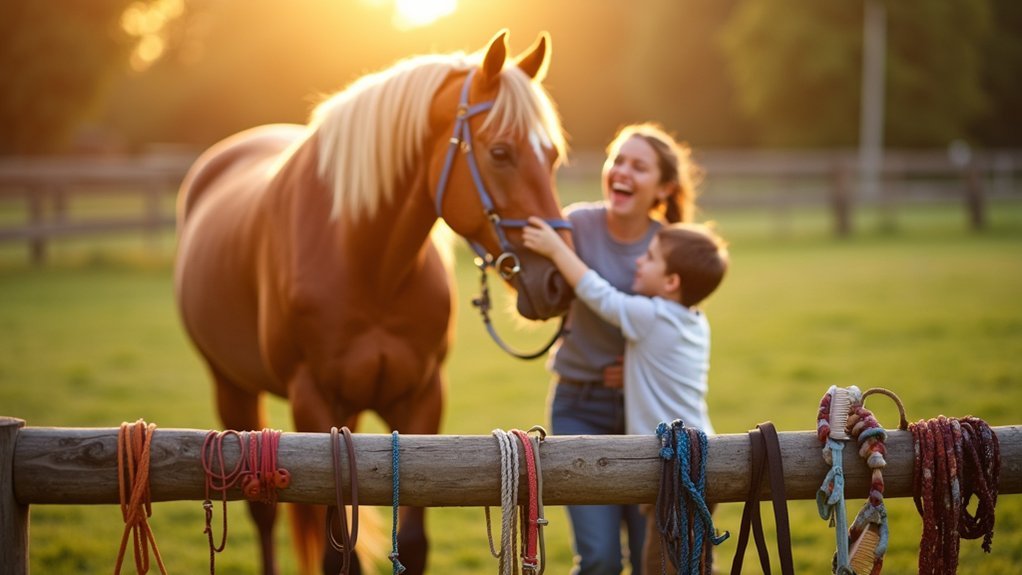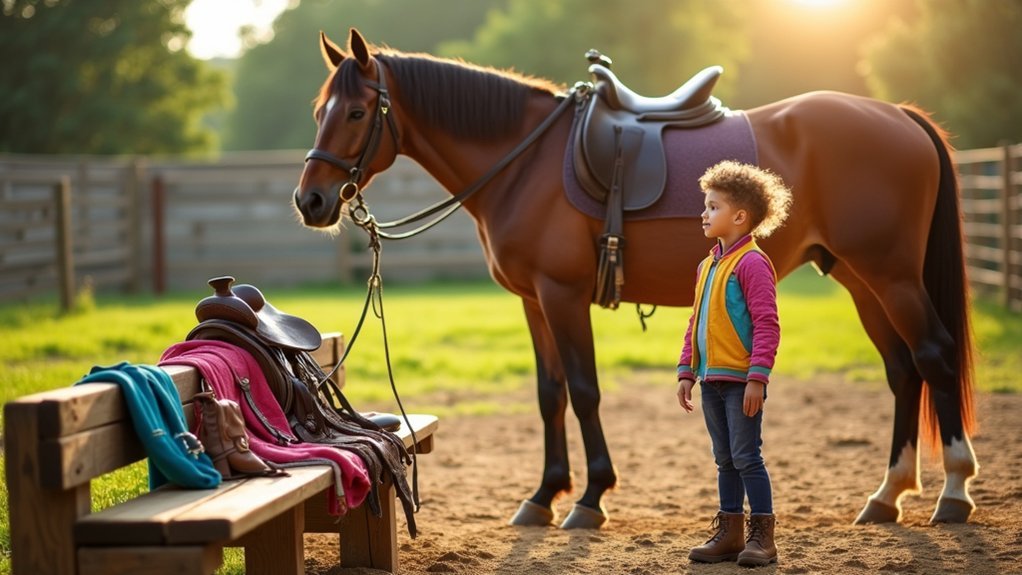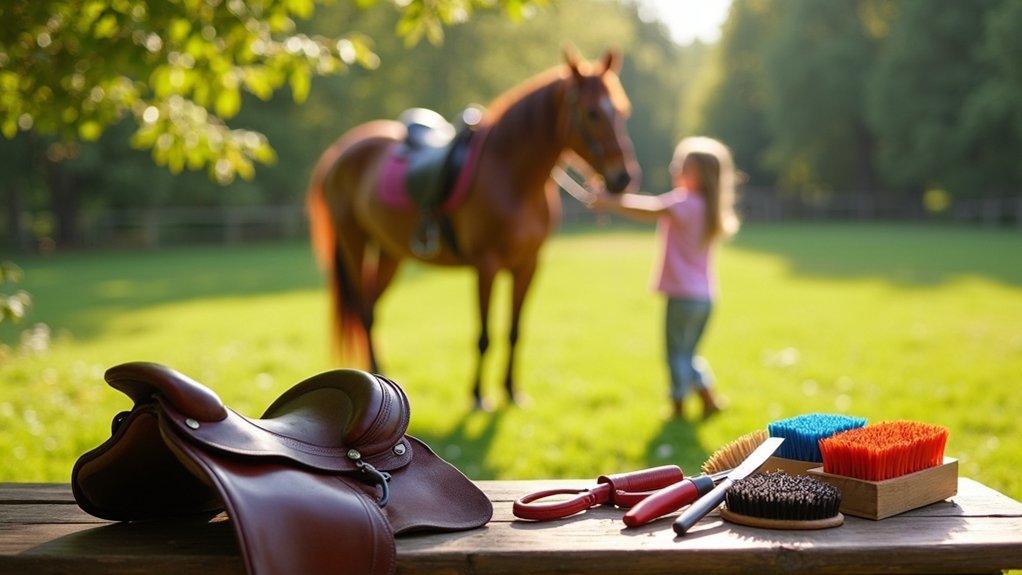Equine therapy offers powerful benefits for autistic individuals through specialized equipment. You’ll need safety helmets, adaptive saddles, and therapeutic reins to create successful sessions. Grip tools greatly enhance sensory integration while supporting fine motor development. Side walkers and mounting blocks accommodate various physical abilities, ensuring accessibility for all participants. Proper equipment creates a safe environment where the unique human-horse bond can flourish, fostering trust, communication, and emotional regulation. Discover how these essential tools transform therapy outcomes.
Equine Tools for Strong Autism Therapy Success

While traditional therapy approaches have proven valuable for individuals with autism, equine therapy offers a unique set of tools that produce remarkable results.
These equine therapy programs create powerful human-horse bonds that help individuals with autism spectrum disorder (ASD) develop trust and empathy naturally.
You’ll find structured activities like grooming and riding specifically designed to improve social skills, communication skills, and emotional regulation.
Certified instructors tailor therapeutic riding sessions to address each person’s specific needs, ensuring safety while promoting gradual development.
Our expert instructors customize every session, prioritizing safety as clients build skills at their own perfect pace.
The benefits for individuals extend far beyond the stable—research shows significant improvements transfer to classroom settings and daily life.
Parents consistently report improved self-esteem and independence in their children.
These success stories demonstrate why equine therapy has become a respected intervention for autism.
The Science Behind Equine-Assisted Therapy for Autism
Research consistently validates the effectiveness of equine-assisted therapy for individuals with autism. Studies show the rhythmic movement during therapeutic horseback riding provides valuable sensory input, helping with sensory processing challenges common in autism. This natural movement contributes greatly to improved emotional regulation and reduced behavioral challenges.
The horse-human connection creates unique opportunities for developing social communication skills, with evidence indicating moderate to high effectiveness in this area. What’s particularly encouraging is that these benefits aren’t temporary—improvements often extend into participants’ daily lives and routines.
Systematic reviews confirm equine-assisted therapy enhances overall quality of life by supporting cognitive, physical, and emotional development simultaneously. The multisensory experience of working with horses creates pathways for communication skills to develop in ways traditional therapies sometimes can’t match.
Essential Riding Equipment That Enhances Therapeutic Outcomes

Five core elements of specialized equipment transform equine therapy sessions for individuals with autism. Safety helmets and body protectors are non-negotiable, providing vital protection while building rider confidence.
You’ll notice specialized saddles offer additional support, improving posture and balance during therapeutic sessions.
Side walkers play an invaluable role, walking alongside horses to provide reassurance and promote engagement. For developing fine motor skills, therapeutic reins with enhanced grip help riders maintain control while fostering independence.
Don’t underestimate the importance of adaptive equipment—mounting blocks and stirrup straps accommodate various physical abilities, ensuring everyone can participate fully.
When properly implemented, this essential riding equipment creates an environment where therapeutic goals are more readily achieved, making each session both safer and more effective.
How Specialized Grip Tools Support Sensory Integration
Transformation occurs when specialized grip tools are introduced to equine therapy sessions for individuals with autism.
These tactile aids provide essential sensory feedback that helps riders develop fine motor skills while interacting with horses. You’ll notice improved hand-eye coordination and emotional regulation as your child engages with textured handles and weighted objects during sessions.
- Enhanced self-regulation – Grip tools help manage sensory input, allowing riders to focus better and control emotional responses during horse interactions.
- Strengthened hand muscles – Vital for successful grooming activities that foster independence.
- Improved attention spans – Sensory integration activities notably enhance engagement levels.
- Developed communication skills – Collaborative tool-based activities encourage social interaction with therapists and peers.
When properly implemented, these specialized tools create a thorough sensory experience that supports your child’s therapeutic journey.
Creating Safe Environments: Equipment for Successful Horse-Rider Bonds

Safety forms the foundation of meaningful connections between riders with autism and their equine partners. When you prepare for therapeutic riding sessions, guarantee proper safety equipment like helmets and boots are always worn to protect both rider and horse in a secure environment.
The therapeutic riding arena should feature soft surfaces and enclosed spaces that minimize distractions, allowing you to focus on building strong horse-rider bonds. Specialized saddles accommodate sensory sensitivities, providing stability and comfort during activities.
Utilize groundwork tools such as lunge lines and lead ropes to facilitate safe interactions that promote trust and communication. Incorporate visual aids and structured cues consistently throughout sessions to help your riders understand expectations clearly.
This structured approach creates an environment where meaningful therapeutic relationships can flourish.
Frequently Asked Questions
Does Equine Therapy Help With Autism?
Yes, research shows equine therapy helps autism notably. You’ll notice improved social communication, better emotional regulation, and enhanced physical skills in your child. Parents report lasting positive changes after these therapeutic sessions.
What Is the Success Rate of Equine Therapy?
You’ll find equine therapy shows a high success rate, with studies reporting moderate to strong effectiveness. You’ll typically see improvements in behavior, social skills, and emotional well-being that often extend beyond therapy sessions.
How Effective Is Equine-Assisted Therapy?
Equine-assisted therapy is highly effective for you. You’ll experience significant improvements in behavioral, social, and motor skills. Research shows moderate to high effectiveness, especially for autism, with benefits extending beyond therapy sessions into everyday life.
What Are the Downsides of Equine Therapy?
You’ll face challenges with equine therapy including variable effectiveness, emotional attachment issues, safety concerns, limited cognitive focus, and restricted access due to program scarcity. It’s not a one-size-fits-all solution for everyone.
In Summary
As you pursue equine therapy for autism, remember that the right tools make all the difference. You’ll see better outcomes when you’ve got proper riding equipment, sensory-supportive grip tools, and safety gear that builds confidence. These aren’t just accessories—they’re essential bridges connecting rider to horse. With thoughtful preparation and appropriate equipment, you’re setting the stage for meaningful therapeutic breakthroughs that can transform lives.





Leave a Reply